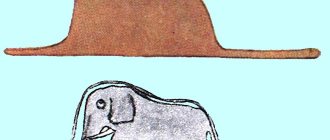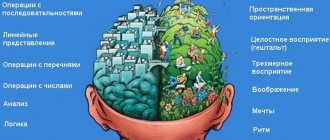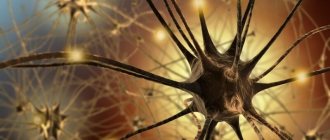“But he’s brainless, he doesn’t understand anything!”, “She’s stupid, she has no brains at all!”, “But those guys are smart, their brains work as they should!” As a rule, in everyday life, people remember the brain exclusively in the context of someone’s ability to think. Although from the school curriculum you should vaguely remember that the tasks of the brain are much broader than thinking and remembering.
You can improve your thinking skills in our Cognitive Science program, and today we will talk about the variety of functions of the human brain and how the human brain works. In the course of the presentation, we will move from simple to more complex, so as not to get confused in the intricacies of structure and functions.
How does the brain work?
Left-handedness is one of the variants of the development of the body, associated with the peculiarities of the functioning of the brain. In left-handed people, interhemispheric interaction and hemispheric specialization are not primarily formed.
Each hemisphere of the brain has its own role.
The left hemisphere is called rational-logical. It controls logical, analytical, abstract thinking. processes information sequentially, progressively, going through all possible options. The left hemisphere is mainly responsible for the right side of the body: it receives information from the right eye, ear, right arm, and leg. The right hemisphere is called the emotional hemisphere. It is responsible for imaginative thinking, perception of art, imagination. The right hemisphere processes information simultaneously, instantly perceiving a holistic image; our ability for emotional perception, synthetic thinking, intuition, and visual-spatial functions rely on it. The right hemisphere serves the left side of the body.
Usually, by the age of 4-5, children develop a leading hand, eye, and ear . The leading left hand (ear, eye) indicates the activity of the right hemisphere. Until this point, children can pick up objects, hold a spoon, draw, cut out, etc. first with one hand, then with the other. Their hemisphere dominance has not yet been established. It is important at this time not to insist that the child perform actions with one hand; when dominance is established, this will happen naturally.
Speech analyzer, Wernicke's center, Broca's center, speech function - sensory center
The speech function is provided by the sensory center ( Wernicke's center ), which is located in the posterior part of the superior temporal gyrus. When Wernicke's center is damaged, sensory aphasia occurs. The speech function is also provided by the motor center ( Broca's center ), which is located in the posterior parts of the inferior frontal gyrus. When Broca's center is damaged, motor aphasia occurs. With pathology at the junction of the temporal and occipital lobes, amnestic aphasia and semantic aphasia are formed. Speech areas of the cerebral cortex.
Left-handedness and left-handedness
The study of the characteristics of left-handers is complicated by the fact that left-handers are not at all a homogeneous group.
Left-handedness determines only the dominant hand, while left-handedness is a complex characteristic that reflects greater activity of the right hemisphere of the brain (unlike right-handed people, in whom the left hemisphere dominates). Thus, if your child prefers to do everything with his left hand, then you can confidently say that he is left-handed. However, whether he is left-handed in general can only be judged after identifying his dominant eye, dominant leg and dominant ear (observing which the child uses more often).
When studying at school, of course, the most important characteristic is the leading hand, since the child will have to master writing.
The most important
Each part of the brain has its own functions.
Together, this complex mechanism works like a well-coordinated team. Tags:
- Brain
2 comments • To leave a comment you must be an authorized user
- DunKarmachka Very interesting, lack of sleep makes it worse for me to think and work. In order to feel less nervous and sleep well, I take Evalar glycine forte. It helps me relieve nervousness and improves brain function. Once I took another glycine from the pharmacy, it didn’t help at all, I didn’t even finish the pack. By the way, I didn’t notice any side effects from taking it.
- burs85 wait)))
Causes of left-handedness
There are various reasons for left-handedness, on which the development of certain qualities in a child may depend.
- Genetic left-handedness.
Left-handedness is 10-12 times more common in families in which at least one of the parents is left-handed
- “Compensatory” left-handedness associated with any damage to the brain, most often to the left hemisphere in the event of any injury or illness at an early stage of the child’s development
- “Forced” left-handedness . The choice of the dominant hand in such left-handers is usually associated with an injury to the right hand, but can also be the result of imitation of family or friends.
- pseudo-left-handedness in children does not develop a dominant hemisphere in relation to the hand. Then pseudo-left-handedness is observed or, what happens more often, approximately equal use of both hands.
Memory, memory function
Various areas are involved in the implementation of the memory function. The frontal lobes provide active, purposeful mnestic activity. The posterior gnostic sections of the cortex are associated with particular forms of memory - visual, auditory, tactile-kinesthetic. The speech zones of the cortex carry out the process of encoding incoming information into verbal logical-grammatical systems and verbal systems. The mediobasal regions of the temporal lobe, in particular the hippocampus, translate current impressions into long-term memory. The reticular formation ensures optimal tone of the cortex, charging it with energy.
Features of left-handers
Left-handed people demonstrate, on the one hand, higher creative abilities (the rigidity of established connections can contribute to more standard thinking), and on the other hand, they demonstrate a slower formation of skills in activities that require the interaction of both hemispheres compared to right-handed people.
Study of the emotional sphere : right-handed people show greater sensitivity to positive emotions, and left-handed people and ambidextrous people are characterized by a predominance of negative emotions, that is, they are more pessimistic. Research conducted at the University of Michigan (according to I. Makaryev) revealed that left-handed people have a predominance of such indicators of temperament such as anger (emotional incontinence), fear (timidity), low mood, comfort, conscientiousness, timidity, aesthetic sensitivity, sensuality, increased level of anxiety.
According to a number of psychologists, left-handers experience particular difficulties adapting to school. According to some authors, the percentage of various kinds of left-handers among children with learning problems is at least 2.5 times higher than the average figures for right-handers.
The usual problems of a left-handed child are persistent difficulties in remembering the direction of the clock hands, determining “left”, “right”, and sometimes “above”, “below”.
In a left-handed world, you can read or write a letter or number with equal probability in any direction (both horizontal and vertical). Accordingly, this extends to more complex actions: reading, writing, counting, remembering, interpreting a plot picture can be started from any side (including from bottom to top). When drawing, for example, a child is not able to adequately distribute the space of the sheet of paper lying in front of him: his drawings creep on top of each other, although there is enough free space around him. The fact is that the starting point for mastering these skills is visual perception.
Impaired or insufficient development of visual-spatial perception, visual memory and hand-eye coordination, often found in left-handed people, leads to the following difficulties:
- perception and memorization of complex letter configurations when reading and a correspondingly slow pace;
- formation of a visual image of letters and numbers (violation of the correlation of elements, the child confuses letters and numbers with similar configurations, writes extra elements or does not complete elements of letters and numbers);
- highlighting and distinguishing geometric shapes, replacing similar shapes (circle - oval, square - rhombus - rectangle);
- copying;
- unstable handwriting (uneven strokes, large, stretched, differently angled letters);
- mirror writing of letters, numbers, graphic elements;
- very slow pace of writing.
with the phenomenon of mirror movements . For some, it manifests itself in the form of mirror writing (the child begins to write with the letter that ends the word, then writes the penultimate one, etc., so if you put a mirror to a written word, you will see the word written in the traditional way in a mirror image ), but there are also mirror reading, mirror drawing, mirror perception.
If, after 10 years, manifestations of mirror perception persist, then it is recommended to conduct a thorough analysis of the type of mirror movements, their causes, and organize special classes that correct deficiencies in spatial perception, coordination, attention, and self-testing skills.
Along with mirror writing, mirror drawing is often observed in children . Inversion is especially characteristic when drawing: top and bottom, vertical and horizontal, right and left change places, and the child does not feel the wrongness.
Left-handers also face enormous difficulties when determining the time on a dial. They not only mirror one or both hands, but also make metric errors - they determine the time with a difference of 10-15 minutes (this also applies to the hour hand).
Typically, most left-handers experience distortions and delays in the development of speech (oral and written), reading, counting, constructive processes, and emotions.
It is important that all these disproportions increase with unqualified retraining of children.
Almost all left-handed children have colossal, almost mystical voluntary control over their mental activity . In many cases, they achieve the desired results in a roundabout way, sometimes finding the most unimaginable external or internal means. Moreover, each time this process is simply unpredictable.
A left-handed child seems to invent his own way of mastering the world of right-handed people every time. At the same time, he has to “pass everything over his head.” And neuropsychologists know that the human brain is an amazingly perfect and subtle instrument, but it also has a finite amount of energy in each specific case. The more energy required for higher mental processes (thinking, speech, counting), the greater the likelihood of “robbing” the basal structures of the psyche (emotional, somatic and others).
It is precisely this mechanism that is often observed in left-handers. If any child requires attention in this sense, then a left-handed child requires three times more attention.
What will the development of each hemisphere give?
First, let's summarize: any human activity begins with a comparison of new data with previous experience, that is, the left hemisphere is involved in this process. At the same time, the right side of the brain influences the final decision - it is physically impossible to come up with something new based only on previous experience.
Such a holistic perception of reality allows one not to get hung up only on generally accepted norms and, accordingly, moves a person’s personal growth forward.
The development of the right hemisphere will help a person to more easily come into contact with others, and the left hemisphere will contribute to the correct expression of thoughts. This approach has a beneficial effect on achieving success not only in professional activities, but also in other activities related to communication within society. Therefore, thanks to the coordinated activity of both hemispheres, a person’s life becomes more harmonious.
To develop these abilities, experts recommend doing simple exercises that activate brain activity several times a day:
- If a person is not good with logic, then he is recommended to engage in mental work as much as possible - solve crosswords or frying pans, and also give preference to solving mathematical problems. If you need to develop creative abilities, then you can try to understand the meaning in fiction or painting.
- You can activate the work of one of the hemispheres by increasing the load on the side of the body for which it is responsible: for example, to stimulate the left hemisphere, you need to work with the right side of the body, and vice versa. In this case, the exercises do not have to be too complicated - just hop on one leg or try to rotate an object with your hand.
Examples of simple physical exercises to develop brain activity
"Ear-nose"
With your right hand you need to touch the tip of your nose, and with your left hand you need to touch the opposite right ear. Then we release them at the same time, clap our hands and repeat the action, mirroring the position of our hands: with our left hand we hold the tip of our nose, and with our right hand we hold the left ear.
"Ring"
This exercise is familiar to almost everyone since childhood: you need to quickly alternately connect your thumb with your index, middle, ring and little fingers into a ring. If everything works out without a hitch, then you can try doing the exercise with 2 hands at the same time.
"Mirror drawing"
Sit down, put a large sheet of white paper on the table, and a pencil in each hand. Then you need to try to simultaneously draw any geometric shapes - a circle, square or triangle. Over time, if everything works out, then you can complicate the task - try to draw more complex images.
It is noteworthy that an integrated approach to improving the activity of the cerebral cortex will help not only improve a person’s communication abilities, but will also slow down age-related changes in the psyche - as is known, an active lifestyle and mental work allow a person to remain young at heart and preserve his intellectual abilities.
Is it worth retraining left-handed children?
To prevent even such doubts, I would like to remind you once again that we are talking not only about the leading hand, but about a certain organization of the brain . By retraining left-handedness, we are unsuccessfully trying to remake the biological nature of the child.
It should be understood that by forcing a child to write with his right hand, we are not able to change the leading hemisphere.
Therefore, the consequences of retraining can be: disturbances in the tempo and rhythm of speech (according to statistics, every third child with a stutter is a retrained left-hander), serious changes in the emotional state of the child (he can become hot-tempered, capricious, irritable, sleep restlessly, eat poorly). Later, even more serious disorders appear: frequent headaches, constant lethargy. As a result, neurotic reactions develop, for example, nervous tics, enuresis, or the functional state of the neuropsychic sphere is disrupted, i.e. neurosis develops, for example, writer's cramp.
Retrained left-handers may have various neurological manifestations: disturbances in appetite and sleep, fears, enuresis (urinary incontinence), tics, stuttering, indigestion, irritability, sudden changes in mood, motion sickness in transport.
Manifestations of neuroses in left-handed children were studied separately :
- Asthenic neurosis. Symptoms of this type of neurosis are manifested in the following: increased fatigue, exhaustion of the nervous system, a sharp decrease in performance. Physically, children can work actively only in the first two lessons, and then it is very difficult to awaken their attention, but then motor disinhibition occurs. Preparing lessons at home usually takes a long time, and the results are unsatisfactory. Written assignments are especially difficult to complete. The handwriting is unstable (letters of different sizes, different inclinations, the line is not followed, many additional strokes, corrections).
- Obsessive-compulsive neurosis. This type of neurosis manifests itself in families where parents are anxious about left-handedness and believe that it can serve as an obstacle in later life. If parents force their children to perform all actions with their right hand, they usually obey and try, even though it turns out poorly. Parents very often see this as disobedience, caprice, stubbornness and punish. Such children develop an anxious expectation of failure, and subsequently develop obsessive thoughts about their inferiority. Such children are quite often worried about school fears of failure and written work.
- Neurotic enuresis. In most cases, only nocturnal enuresis is observed, but it can also occur during the day. Enuresis causes feelings of guilt and fear of punishment. Performance decreases even more, the child cannot concentrate, and a vicious circle is formed.
- Neurotic tics. Tics include: blinking, lip licking, forehead wrinkling, nose twitching. Such phenomena rarely cause excitement and concern among parents. The child does not control these movements. Tics are not directly related to performing tasks with the right hand, but intensify when the child is tired or nervous.









